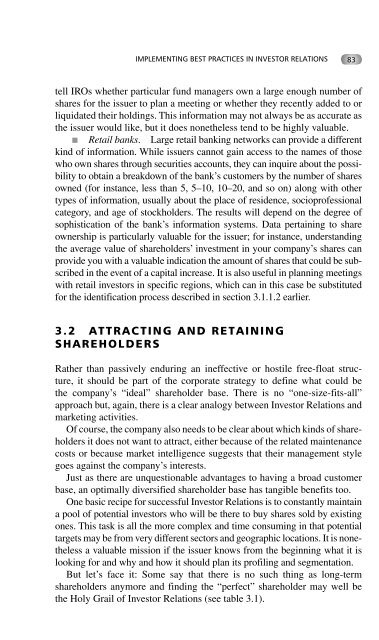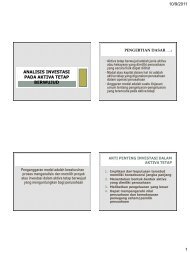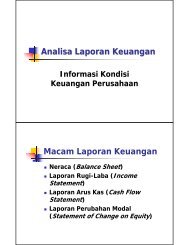Investor Relations
Investor Relations
Investor Relations
- No tags were found...
Create successful ePaper yourself
Turn your PDF publications into a flip-book with our unique Google optimized e-Paper software.
IMPLEMENTING BEST PRACTICES IN INVESTOR RELATIONS 83tell IROs whether particular fund managers own a large enough number ofshares for the issuer to plan a meeting or whether they recently added to orliquidated their holdings. This information may not always be as accurate asthe issuer would like, but it does nonetheless tend to be highly valuable. Retail banks. Large retail banking networks can provide a differentkind of information. While issuers cannot gain access to the names of thosewho own shares through securities accounts, they can inquire about the possibilityto obtain a breakdown of the bank’s customers by the number of sharesowned (for instance, less than 5, 5–10, 10–20, and so on) along with othertypes of information, usually about the place of residence, socioprofessionalcategory, and age of stockholders. The results will depend on the degree ofsophistication of the bank’s information systems. Data pertaining to shareownership is particularly valuable for the issuer; for instance, understandingthe average value of shareholders’ investment in your company’s shares canprovide you with a valuable indication the amount of shares that could be subscribedin the event of a capital increase. It is also useful in planning meetingswith retail investors in specific regions, which can in this case be substitutedfor the identification process described in section 3.1.1.2 earlier.3.2 ATTRACTING AND RETAININGSHAREHOLDERSRather than passively enduring an ineffective or hostile free-float structure,it should be part of the corporate strategy to define what could bethe company’s “ideal” shareholder base. There is no “one-size-fits-all”approach but, again, there is a clear analogy between <strong>Investor</strong> <strong>Relations</strong> andmarketing activities.Of course, the company also needs to be clear about which kinds of shareholdersit does not want to attract, either because of the related maintenancecosts or because market intelligence suggests that their management stylegoes against the company’s interests.Just as there are unquestionable advantages to having a broad customerbase, an optimally diversified shareholder base has tangible benefits too.One basic recipe for successful <strong>Investor</strong> <strong>Relations</strong> is to constantly maintaina pool of potential investors who will be there to buy shares sold by existingones. This task is all the more complex and time consuming in that potentialtargets may be from very different sectors and geographic locations. It is nonethelessa valuable mission if the issuer knows from the beginning what it islooking for and why and how it should plan its profiling and segmentation.But let’s face it: Some say that there is no such thing as long-termshareholders anymore and finding the “perfect” shareholder may well bethe Holy Grail of <strong>Investor</strong> <strong>Relations</strong> (see table 3.1).











